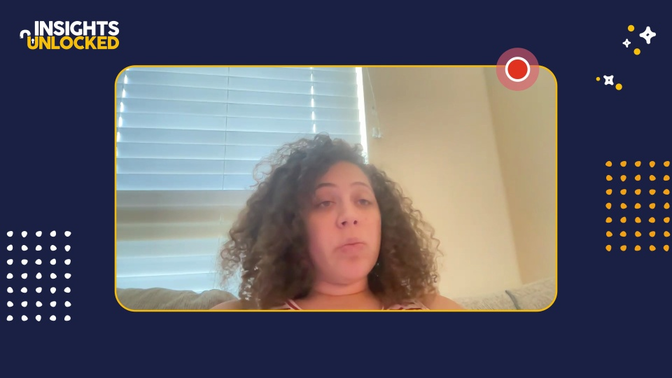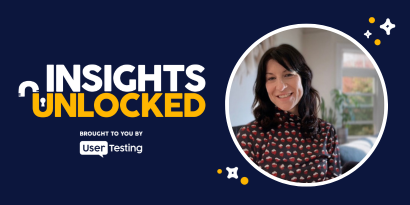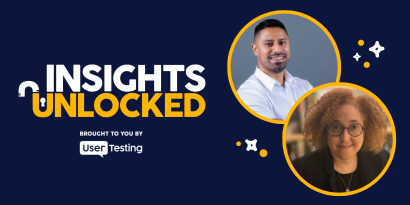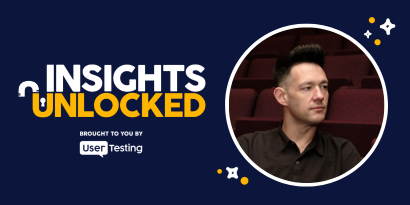
Episode 92 | September 18, 2024
Bridging silos to create better customer-centric experiences
In this week’s Insights Unlocked, UserTesting’s Sean Treiser talks with Deborah Roberts about bridging the silos that can often occur within teams and departments.
Bridging silos to create better customer-centric experiences
Bridging silos should be the goal for customer-centric businesses. Not doing so risks your customer’s experience feeling disjointed, dysfunctional and all-around disagreeable.
In this week’s Insights Unlocked, UserTesting’s Sean Treiser talks with Deborah Roberts, about bridging the silos that can often occur within teams and departments. They offer up a range of actionable tips including using structured collaboration tools like FigJam, using visuals like journey maps or highlight reels and making sure to tie it all back to business goals.
Deborah is a senior UX designer at UpTop, a Seattle-based user experience agency where she has worked on projects that range from large online retailers and B2B technology companies to healthcare and fashion. Sean is UserTesting’s Insights Strategist and often writes articles for the Center for Human Insights.
Deborah explained that silos often form due to departmental differences, distinct budgets, and the potential impact of one team's work on another. Leadership also plays a crucial role in breaking down silos by emphasizing collaboration and common objectives.
“We’re in the business of creating consistent and compelling experiences. Our customers don’t care who built this piece or that piece. All they want is a clean, simple experience that they can have clear expectations about how to get what they need done,” Sean said. “These silos actually can introduce friction into that experience inadvertently, despite everybody having, hopefully, the same best intentions.”
To tee up their conversation, we asked UX researchers in the UserTesting Participant Network their thoughts and tips for bridging these silos. Listen to what they said in the video below:

Using structured collaboration to build alignment
No one wants more meetings in their work week to build alignment. Deborah likes to use structured collaboration tools, like FigJam or UserTesting’s EnjoyHQ, to help streamline the process and be able to asynchronously work across different teams, departments and time zones. Those tools can be used internally as a place to collect materials, share notes, review previous research and so forth. They can also use those tools and platforms to make more formal presentations or workshops with internal or external stakeholders.
“It's been a really great way to get people together from different parts of the organization,” Deborah said. “It just gets everyone on the same page, especially at the beginning of a project.
Getting aligned using customer journey maps
Deborah highlighted the power of visuals in communicating the customer experience.
Visual tools like user journey maps or highlight reels can help teams understand pain points, goals, and opportunities in the user's journey.
“I really love user journey maps,” Deborah said. “I think it’s a great way to break it down and look at, step by step, in the process of when a customer or user starts engaging with your digital experience.”
With these visuals, you can map what is happening at each stage, what users may be looking for, who they may be interacting with, and identify any big and small pain points they may encounter.

Deborah said you can also map what is happening internally, too, along the customer journey.
“We’ll start to include that onto the journey maps that we’re building so that we can see, ‘OK, at these really sticky points for the user, our customer, what’s happening internally? Is that having any impact?,’” Deborah said.
“It is amazing how much clearer we can communicate with visuals involved. Especially video, where there’s a human expressing emotion,” Sean said. “Our mirror neurons start firing without even thinking about it and all of a sudden we have real empathy for the person on the other side of it.”
And then, Deborah said, “Bringing it back to the business case and saying, ‘OK, if we fix this, we’re going to make our internal teams more efficient; we’re going to save time and money; we’re going to improve the customer experience. They are going to be able to find what they need quicker and that’s going to lead to bigger revenue.”
Three tactics toward creating a customer-centric experience
Sean said creating a journey map helps reframe business problems from the user’s perspective. “And the second we start in their shoes, it’s only natural to continue down that path and start asking more customer-centric questions,” he said.
Stakeholder interviews are another way both better understand the customer’s experience, as well as get everyone aligned. Deborah suggests working with the main project owner to identify who are the people they should talk with to get a full understanding of the project. Additionally, you’ll want to engage others who have a critical role in a project’s success, whether they are directly connected to it or not.
“We’ll ask them how this initiative will impact them, what they think is important about it, any insights they have and what success looks like to them,” Deborah said.
And, bringing it all together, a third tactic toward bridging silos is holding an alignment workshop, where you can all review the qualitative and quantitative research that’s already been done; review the journey maps you’ve created; review the stakeholder interviews, and so forth.
“I love the idea of an alignment workshop,” Sean said. “Just totally rallying around, ‘What do we already know?’ Because there is almost always a sea of knowledge about our customers just not being shared or documented. So when you give people a chance to both share, document and then engage with each other in synthesizing that information, I’m sure it can be a really powerful kind of Aha moment.”
Connecting experience research with business goals and KPIs
Deborah stressed the significance of tying user experience efforts to the organization's business goals and KPIs. Connecting the dots between UX research, personas, and journey maps with the impact on revenue and customer acquisition helps make a strong case for a customer-centric approach.
Deborah suggests starting small. “You might have this big vision of where you want to be,” she said, “But instead of just leaping toward that, figure out ‘What’s a small chunk that I can tackle, that I can make a success, that I can have some quick wins, and I can show how that’s impacted both the user experience and the business.”
That baby-steps approach toward customer-centricity allows you to create a road map from which to work from, establish small wins along the way, and get organizational buy-in throughout the process. Deborah shared an example where they leveraged the work from a cross-functional workshop to create a short video that narrated a future state of a project. They then shared that ‘north star' vision and ultimately received funding for it.
Episode links:
- Deborah Roberts on LinkedIn
- UpTop
- Sean Treiser on LinkedIn
- Center for Human Insights










